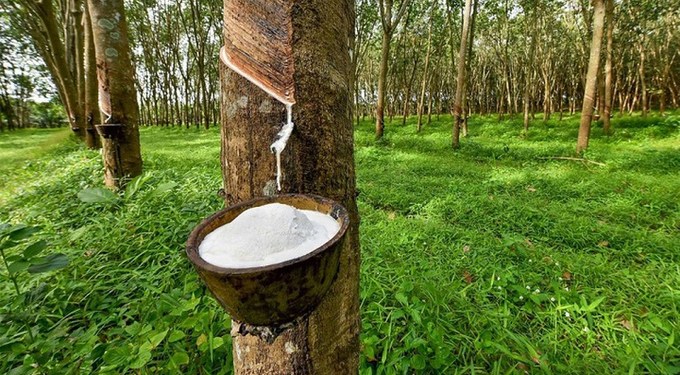Introduction: China’s natural rubber imports moved up MoM for two consecutive months, but the increment in August was smaller than that in July. Compared with the same period in history, the total imports in August were slightly higher than the average level of 484.5kt in the past five years. In terms of different rubber types, except for the MoM decline in standard rubber imports, imports of other types all increased MoM. In contrast, except for the YoY increase in imports of standard rubber and compound rubber, imports of other types all declined YoY. In September, China’s natural rubber imports may continue to rise MoM but decline YoY.
In August, China’s natural rubber imports rose slightly MoM but fell YoY
According to GACC, China’s natural rubber imports in August 2024 were about 494.2kt, up 2.09% MoM but down 9.47% YoY. From January to August, the total imports of natural rubber were about 3,449.8kt, down 876.7kt or 20.26% YoY. The MoM growth rate slowed down in line with the decrease in the entry of quota for alternative plantation in August. On the other hand, changes in customs clearance policies of some domestic ports in August led to the weak clearance of some goods sources, leading to a disturbance to the arrival at the port. The YoY decrement in imports was directly in line with overseas production cuts this year on the one hand. On the other hand, the international phased replenishment demand caused a part of the volume to China to be diverted.
Imports analysis of China’s natural rubber imports by types
In August, the imports of each kind of rubber increased MoM except for standard rubber. The imports of mixed rubber, NR latex, and RSS declined YoY significantly in addition to the growth trend YoY in imports of standard rubber and compound rubber. Among those, in August, mixed rubber import volume was still China’s largest of natural rubber imports, which was 258.1kt, up 1.79% MoM but down 11.1% YoY.
|
Product |
Import volume (kt) |
M-O-M change rate |
Y-O-Y change rate |
| Natural rubber (10 HS codes) |
484.20 |
+2.09% |
-9.47% |
| Mixed rubber |
258.10 |
+1.79% |
-11.10% |
| Standard rubber |
188.40 |
-1.92% |
+0.76% |
| NR latex |
25.80 |
+35.69% |
-22.59% |
| RSS |
17.30 |
+14.60% |
-44.04% |
| Compound rubber |
4.70 |
+6.22% |
+6.25% |
In August, mixed rubber imports increased by 1.79% MoM but decreased by 11.1% YoY
In August, the import volume of mixed rubber was 258.1kt, up 1.79% MoM, down 11.1% YoY. In addition to the decline MoM of imports from Laos and Myanmar, the imports from Thailand, Vietnam and Malaysia all increased MoM. In August, the import volume of mixed rubber from Thailand was 102.6kt, up 0.43% MoM, down 1.71% YoY, ranking first. With Thailand entering the increasing production season, the natural rubber output increased. Besides, some early orders were delivered this month, so the export volume of Thailand increased. However, it was still less than the high level of previous years, mainly related to Thailand’s weak output from January to August. Also, it was said that the output in Laos and Myanmar was cut from July to August due to the impact of the rainy season, resulting in a decline in exports.
In August, the import volume of standard rubber decreased by 1.92% MoM and increased by 0.76% YoY
Standard rubber import volume in August was 184.4kt, and the fluctuation range was narrow. In terms of the narrow fluctuation range MoM, it was mainly in line with the decline in import quota for alternative plantation from Laos and Myanmar. The import volume of standard rubber from Laos in August was 31.5kt, down 11.5kt MoM. That from Myanmar was 15.6kt, down 5.7kt MoM. That from Cote d’ivoire was 36.2kt in the month, but the cumulative imports from January to August were 218.5kt, down 38.33% YoY. The price of exports from Cote d’ivoire to China was not advantaged compared with that to The European Union, India, and other countries, eating up part of the exports to China. In addition, the imports from Indonesia were 17.5kt in August, mainly related to the delivery profits of NR.
China’s natural rubber imports may continue to increase MoM in September. On the one hand, according to historical seasonal performance, the probability of natural rubber imports’ growth in September is 80%. Foreign countries are expected to gradually enter the increasing production season, and the supply may increase, which may lead to an increase in exports. On the other hand, the arbitragers in Q2 increased forward-month contracts, and some early orders delayed delivery were shipped. Thus, the volume of port arrivals in September may rise. In general, the imports are expected to increase MoM in September. In contrast, China’s natural rubber imports may continue to decrease YoY in September. This year, the release of new rubber output overseas is unsmooth, and much rainfall in producing areas from August to September has affected the output. Besides, international replenishment demand weighs on the export volume to China.























